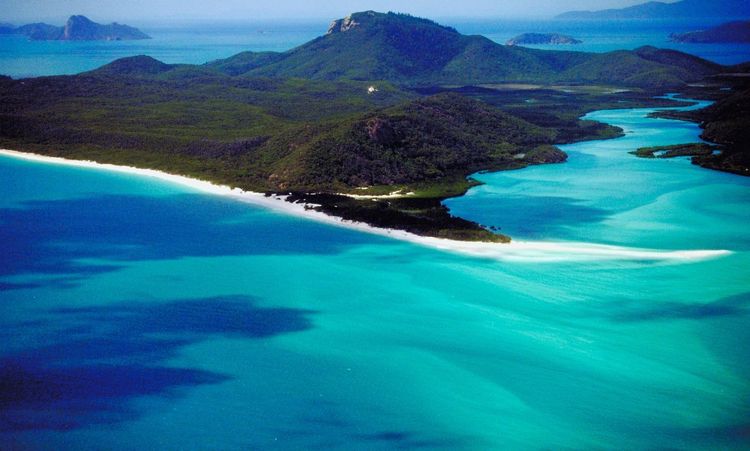The Great Barrier Reef is one of the world's most magnificent natural wonders, stretching over 2,300 kilometers along Australia's Queensland coast. As an avid diver who's explored these waters multiple times, I can tell you that choosing where to dive in this massive ecosystem can be overwhelming! With countless dive sites scattered across this marine playground, each offering unique underwater experiences, how do you pick the best spots? Whether you are a beginner or an experienced diver, this guide will help you plan your ultimate underwater adventure.
Whitsunday Islands

The Whitsunday Islands offer some of the most accessible and breathtaking diving experiences in the Great Barrier Reef. Nestled between the Queensland coast and the outer reef, these 74 islands provide sheltered waters perfect for divers of all experience levels.
The fringing reefs surrounding islands like Hook, Hayman, and Border showcase vibrant coral gardens teeming with marine life. Expect to encounter colorful parrotfish, curious Maori wrasse, and schools of tropical fish darting through the coral formations. The calm, clear waters offer excellent visibility, typically 10-20 meters, depending on the season.
When I visited the Whitsundays last year, our dive instructor took us to a secluded spot near Langford Island, where we swam alongside a gentle sea turtle for nearly 20 minutes! Watching it gracefully navigate the coral garden while rays of sunlight filtered through the water remains one of my favorite diving moments.
Tangalooma Wrecks
These 15 vessels were deliberately sunk between 1963 and 1984 to create a break wall and haven for marine life—and they've certainly succeeded!
Today, these wrecks have transformed into artificial reefs harboring an incredible diversity of marine species. The structures create a fascinating underwater maze where divers can spot wobbegong sharks resting on the sandy bottom, octopuses hiding in crevices, and schools of kingfish circling the upper sections.
The best diving conditions typically occur during winter (June to August) when water visibility improves to 15-20 meters. Plankton blooms can reduce visibility during summer but attract larger filter-feeding species, offering different but equally rewarding experiences.
Hardy Reef
Hardy Reef is one of the most iconic outer reef destinations, about 70km offshore from Airlie Beach. This massive reef system features stunning coral formations, incredible biodiversity, and the Heart Reef, a naturally formed heart-shaped coral arrangement that has become a symbol of the Great Barrier Reef.
The diving at Hardy Reef is exceptional, with wall dives, coral gardens, and swim-throughs providing varied underwater landscapes. The deeper waters attract larger marine species, including reef sharks, eagle rays, and occasionally manta rays during certain seasons.
For photographers, Hardy Reef offers incredible visibility and diverse underwater compositions, from macro shots of tiny nudibranchs to wide-angle vistas of expansive coral gardens.
Osprey Reef
Located 125km northeast of Cairns in the remote Coral Sea, this isolated oceanic reef rises dramatically from depths of over 1,000 meters, creating a diving environment unlike anywhere else.
Osprey Reef's signature dive site, North Horn, has earned legendary status among experienced divers. The site features an underwater amphitheater where divers can witness shark feeding demonstrations in a controlled environment. White-tip reef sharks, grey reef sharks, and occasionally hammerheads congregate here, creating an electrifying diving experience.
The sheer walls dropping into the deep blue, stunning visibility often exceeding 40 meters, and chance encounters with pelagic species make Osprey Reef worth the journey. Due to its remote location, diving Osprey Reef typically requires a multi-day liveaboard trip, with operators like Mike Ball Dive Expeditions offering comprehensive packages.
Lady Elliot Island
Lady Elliot Island sits at the southern tip of the Great Barrier Reef, offering some of the most pristine and healthy coral systems in the entire reef. This small coral cay is renowned for its crystal-clear waters and year-round population of manta rays, earning it the nickname "Home of the Manta Ray."
The island's location at the meeting point of tropical and temperate waters creates a unique ecosystem where diverse marine species thrive. Over 1,200 marine species have been recorded in the waters surrounding Lady Elliot, including manta rays, turtles, reef sharks, and humpback whales during winter months (June to October).
Lady Elliot Island Eco Resort is the only accommodation on the island, and packages include flights from the mainland, accommodation, and diving. The resort's commitment to sustainability extends to its diving operations, ensuring minimal impact on the fragile reef ecosystem.
SS Yongala Shipwreck
The SS Yongala shipwreck is Australia's greatest wreck dive and consistently ranks among the top wreck dives worldwide. This 110-meter passenger ship sank during a cyclone in 1911 off the coast of Townsville, creating what would become an extraordinary artificial reef.
What makes the Yongala special is the incredible concentration of marine life that has made the wreck home. The structure is a magnet for marine species in an otherwise sandy, featureless seafloor. Giant Queensland groupers, eagle rays, sea snakes, turtles, and schools of trevally create a living spectacle around the historic vessel.
Day trips operate from Ayr and Townsville, while some liveaboard expeditions include the Yongala in their itineraries. The best visibility occurs during winter (June to August), though marine life remains abundant year-round.
Museum of Underwater Art
For a truly unique diving experience that blends art with marine conservation, the Museum of Underwater Art (MOUA) near Townsville offers something unique. Created by renowned underwater sculptor Jason deCaires Taylor, this underwater installation includes the "Coral Greenhouse" at John Brewer Reef and "Ocean Siren" near Townsville's Strand.
The site attracts diverse marine life, from tiny gobies taking shelter among the sculptures to schools of snapper and the occasional reef shark patrolling the perimeter. The interplay of sunlight, marine growth, and artistic design creates captivating underwater scenes perfect for photography enthusiasts.
Dive trips to MOUA operate from Townsville, with options for certified divers and introductory experiences for beginners. The site's moderate depth makes it accessible while offering substantial bottom time to appreciate the artistic details and surrounding marine environment.
Capricorn and Bunker Reefs

The Capricorn and Bunker group of reefs and islands represent the southernmost section of the Great Barrier Reef, offering exceptional diving opportunities away from the more visited northern sections. This group includes Lady Musgrave Island, Heron Island, and Wilson Island, each providing access to pristine reef systems.
The Heron Island dive sites stand out with over 20 dive spots accessible via short boat rides from the island resort. The Heron Bommie features spectacular coral formations and the chance to spot reef sharks, rays, and, during seasonal aggregations, hundreds of mating green sea turtles.
Lady Musgrave Island offers incredible lagoon diving for beginners, while the outer reef provides more challenging experiences with deeper drop-offs and stronger currents. The island's protected lagoon is a natural nursery for juvenile fish species, offering fascinating insights into reef ecology.
Wonder Reef
A newer addition to Queensland's diving scene, Wonder Reef opened in 2022 as the world's first buoyant reef attraction. Located 2.5km off the Gold Coast's Main Beach, this engineered diving site consists of nine enormous sculptural reef flutes anchored to the seafloor, creating a vertical reef experience.
The structures rise 22 meters from the ocean floor and are designed to move with ocean currents like underwater kelp forests. This movement, combined with purpose-built habitats, has quickly attracted diverse marine life, including tropical and subtropical species.
While still developing as a marine ecosystem, Wonder Reef already demonstrates how thoughtfully designed artificial reefs can enhance marine biodiversity while providing new diving opportunities.
Conclusion
The Great Barrier Reef is an ocean playground of thousands of kilometers, and each segment offers a distinct diving experience. When organizing your dive adventure, consider your certification level, travel time, finances, and the type of marine life you want to observe. The remote waters of the Whitsundays, the fringing reefs at Lady Elliot Island, or the shallow Tangalooma Wrecks are the perfect places for beginners to try Great Barrier Reef diving. Thrill-seeking senior divers will experience the ride to Osprey Reef, the SS Yongala, and the outside walls of the Ribbon Reefs.




